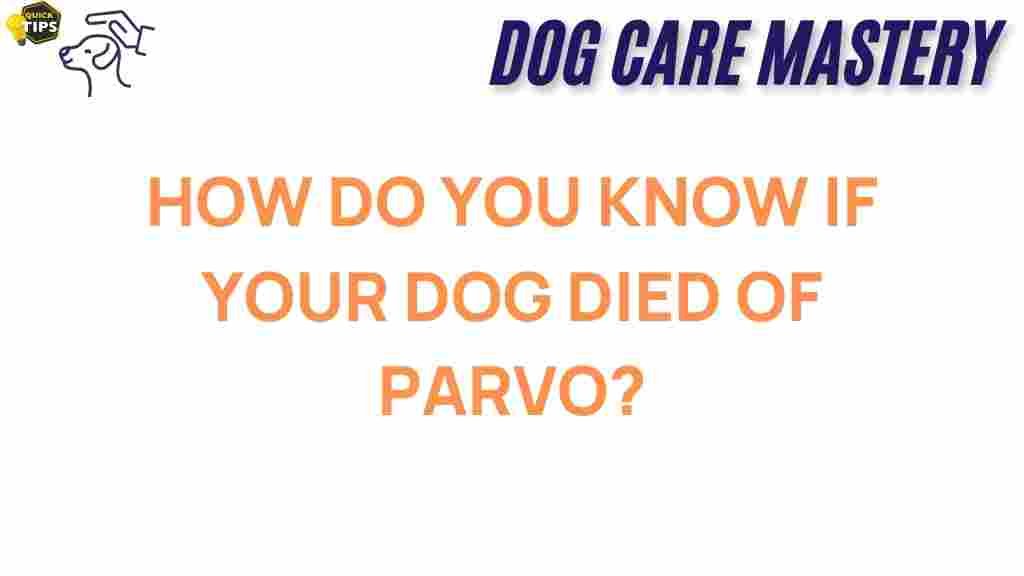Unraveling Parvo: How to Recognize Its Fatal Signs in Dogs
Parvo, short for canine parvovirus, is a highly contagious viral illness that poses a significant threat to dogs, particularly puppies and unvaccinated dogs. This disease can be fatal if not promptly treated, making it crucial for dog owners to know how to recognize the signs of parvo. In this article, we will explore the symptoms, diagnosis, treatment options, and preventive measures for parvo, empowering you to protect your furry friend.
Understanding Parvo
Parvo is primarily spread through contact with infected feces, and it can survive in the environment for months. The virus attacks rapidly dividing cells, affecting the gastrointestinal tract and immune system, which can lead to severe dehydration and other life-threatening complications.
Identifying the Symptoms of Parvo
The symptoms of parvo can vary in severity, but early recognition is crucial for effective treatment. Here’s a list of common signs to look out for:
- Severe Vomiting: Persistent vomiting is one of the most notable symptoms of parvo. Dogs may vomit multiple times a day, which can lead to dehydration.
- Diarrhea: Watery, foul-smelling diarrhea, often containing blood, is a significant indicator of parvo.
- Lethargy: Infected dogs may exhibit extreme fatigue and lack of energy, showing little interest in play or normal activities.
- Loss of Appetite: A sudden decrease in appetite or refusal to eat can be a warning sign of illness.
- Fever: Elevated body temperature can indicate an infection or illness.
- Abdominal Pain: Dogs may show signs of discomfort or pain when their abdomen is touched.
If you notice any of these symptoms in your dog, it’s essential to consult your veterinarian immediately.
The Importance of Early Diagnosis
Diagnosing parvo can be challenging, as its symptoms can resemble other illnesses. Your veterinarian will typically perform a physical exam and may conduct tests such as:
- Fecal Test: A quick and effective test that detects parvovirus antigens in the stool.
- Blood Tests: Blood work can help assess the dog’s overall health and identify dehydration or infection.
- X-rays or Ultrasound: Imaging may be used to check for intestinal blockages or other complications.
Timely diagnosis is critical. Early intervention can significantly improve your dog’s chances of survival.
Treatment Options for Parvo
If your dog tests positive for parvo, treatment typically involves supportive care, as there is no specific cure for the virus. Here’s what you can expect:
- Hospitalization: Most dogs with parvo require hospitalization to manage their condition effectively.
- IV Fluids: Administering intravenous fluids helps combat dehydration and maintain electrolyte balance.
- Medications: Your veterinarian may prescribe anti-nausea medications, antibiotics to prevent secondary infections, and other supportive medications.
- Nutrition: Once vomiting subsides, your vet may recommend a special diet to help your dog recover.
During treatment, your dog will be monitored closely to manage any complications that arise.
Preventing Parvo
Prevention is the best strategy when it comes to parvo. Here are some effective ways to protect your dog:
- Vaccination: Ensure your dog receives the complete series of vaccines, especially puppies, who are at the greatest risk. Vaccination against parvo is a crucial part of a puppy’s vaccination schedule.
- Avoid High-Risk Areas: Steer clear of places where many dogs gather, such as dog parks or grooming salons, until your dog is fully vaccinated.
- Practice Good Hygiene: Regularly clean your dog’s living area and avoid contact with feces from other dogs.
- Limit Exposure: If your dog is unvaccinated, limit their exposure to other dogs, especially those showing signs of illness.
For more information on dog vaccinations, you can visit this helpful resource.
Troubleshooting Common Concerns
As a dog owner, you may have several concerns regarding parvo. Here are some common issues and solutions:
- My dog has been vaccinated; can they still get parvo? While vaccination significantly reduces the risk, no vaccine is 100% effective. Always monitor for symptoms, especially in high-risk environments.
- What should I do if my dog is exposed? Contact your veterinarian immediately for advice. They may recommend vaccinations or additional precautions.
- How long does the virus survive in the environment? Parvovirus can survive for months in the right conditions, so thorough cleaning of contaminated areas is essential.
- Will my dog recover from parvo? Many dogs can recover with prompt treatment, but the prognosis depends on the severity of the infection and how quickly treatment begins.
Conclusion
Understanding the signs of parvo is vital for every dog owner. Early recognition and prompt veterinary care can mean the difference between life and death for your beloved pet. By being vigilant about your dog’s health, ensuring vaccinations are up to date, and practicing good hygiene, you can significantly reduce the risks associated with parvo.
If you suspect your dog may have parvo, do not hesitate to seek veterinary help. Remember, your dog’s health and happiness are in your hands. Stay informed, stay proactive, and together, we can fight against parvo.
For more information on canine health and diseases, check out this detailed guide.
This article is in the category Health and created by dogcaremastery Team
